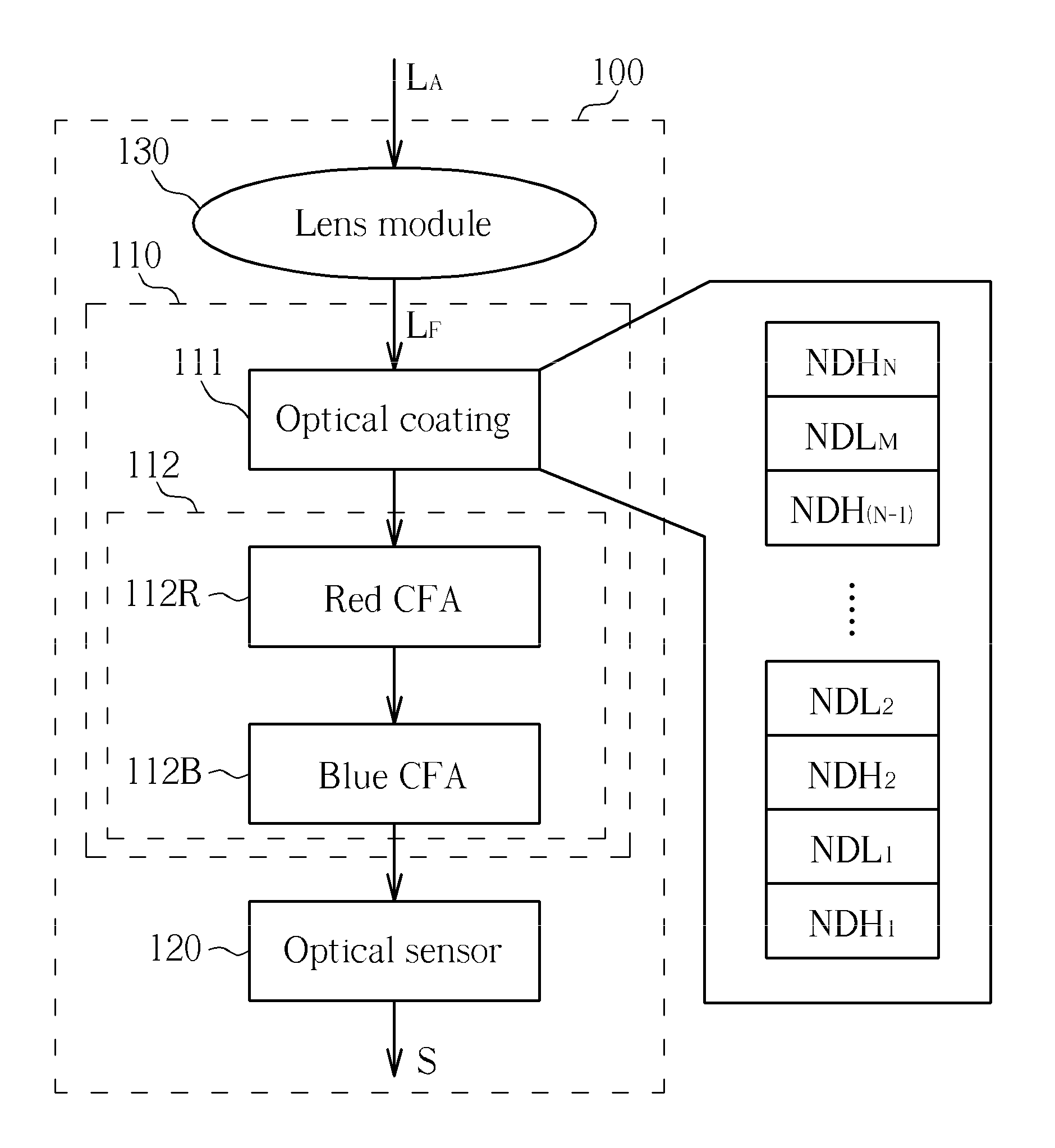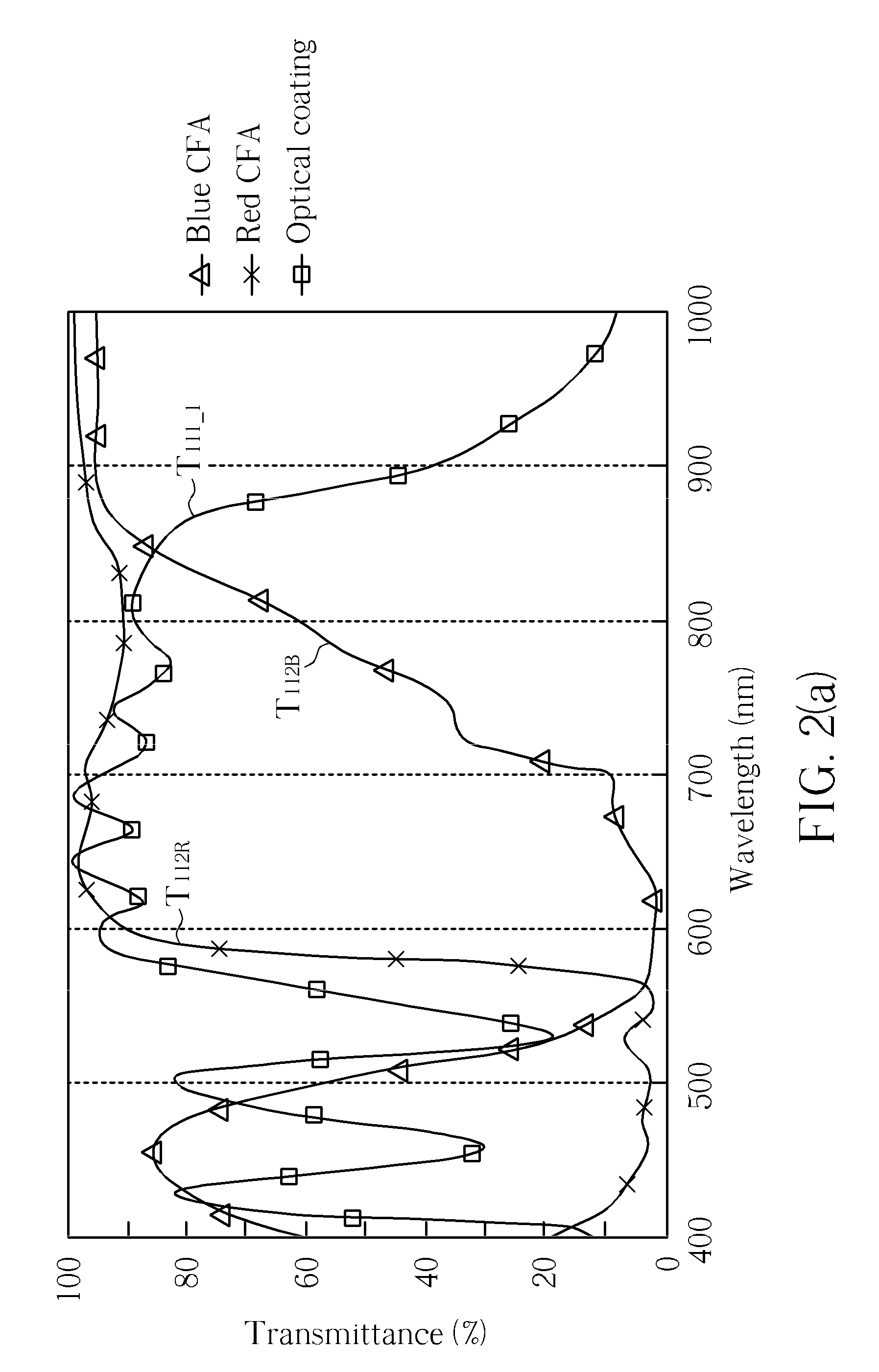IR sensing device
a sensing device and infrared radiation technology, applied in the field of infrared radiation sensing devices, can solve the problems of deteriorating the malleability and flexibility of optical coatings, the inability of optical coatings to be coated on the lenses nor the optical sensors, and the inability to achieve high cost and production difficulty
- Summary
- Abstract
- Description
- Claims
- Application Information
AI Technical Summary
Benefits of technology
Problems solved by technology
Method used
Image
Examples
first embodiment
[0028]Please refer to FIG. 1. FIG. 1 is a diagram illustrating an IR sensing device 100 according to the present invention. The IR sensing device 100 comprises an IR pass filter 110, an optical sensor 120, and a lens module 130. An optical path exists on the IR sensing device 100 for allowing an ambient light LA to enter the optical sensor 120.
[0029]The lens module 130, disposed on the optical path, provides a focused light LF out of an ambient light LA from a scene. That is, the lens module 130 focuses the ambient light LA to be the focused light LF. The optical sensor 120, disposed on the optical path, may comprise a photo diode, where photons absorbed by the photo diode generate an electrical signal S, either a voltage or current signal, indicative of the number of photons absorbed by the photo diode.
[0030]The IR pass filter 110, disposed on the optical path, comprises an optical coating 111, and a CFA module 112. The CFA module 112 comprises a red and a blue CFAs 112R and 112B. ...
second embodiment
[0035]Please refer to FIG. 4. FIG. 4 is a diagram illustrating an IR sensing device 400 according to the present invention. The IR light sensing device 400 comprises an IR pass filter 410, an optical sensor 120, and a lens module 130. The IR pass filter 410 comprises an optical coating 111, and a CFA module 412. The CFA module 412 comprises a red CFA 112R, a blue CFA 112B, and a green CFA 112G. The green CFA 112G mainly blocks light with the wavelength around 400 nm to 475 nm, and the wavelength around 600 nm to 780 nm.
[0036]Please refer to FIG. 5. FIG. 5(a) is a diagram illustrating the transmittance spectrums T111—1, T112R, T112B, and T112G respectively of the optical coating 111 with the first setting, the red CFA 112R, the blue CFA 112B, and the green CFA 112G of the present invention. FIG. 5(b) is a diagram illustrating the resulting transmittance spectrum T410—1 of the IR pass filter 410 of the present invention from FIG. 5(a). In the sensitive range for the optical sensor 120...
third embodiment
[0038]Please refer to FIG. 7. FIG. 7 is a diagram illustrating the structure view of the IR sensing device 700 according to the present invention. The IR sensing device 700 may be realized with the IR sensing devices 100 or 400. As shown in FIG. 7, the CFA module 712, the optical coating 711, and the optical sensor 720 can be integrated as an Integrated Chip (IC). More particularly, in the IC, the CFA module 712 is coated on the optical sensor 720, and the optical coating 711 is coated on the CFA module 712. The lens module 730 is disposed on the upside of the optical coating 711 of the IC.
PUM
 Login to View More
Login to View More Abstract
Description
Claims
Application Information
 Login to View More
Login to View More - R&D
- Intellectual Property
- Life Sciences
- Materials
- Tech Scout
- Unparalleled Data Quality
- Higher Quality Content
- 60% Fewer Hallucinations
Browse by: Latest US Patents, China's latest patents, Technical Efficacy Thesaurus, Application Domain, Technology Topic, Popular Technical Reports.
© 2025 PatSnap. All rights reserved.Legal|Privacy policy|Modern Slavery Act Transparency Statement|Sitemap|About US| Contact US: help@patsnap.com



